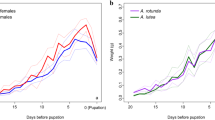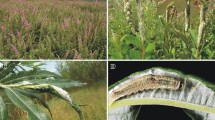Abstract
The expansion of available resources leads organisms to adapt to novel niches and create new biological interactions. Galerucella grisescens (Coleoptera: Chrysomelidae) is usually associated with Polygonaceae in Japan but a population feeding on an invasive plant species Myriophyllum aquaticum (Haloragaceae) was found in Chiba Prefecture, Honshu. To infer the process of host range expansion and possible rapid adaptations of G. grisescens to M. aquaticum, we studied larval host plant suitability and female oviposition site preference by G. grisescens in different strains. In laboratory rearing experiments, adult body weight and egg mass size of G. grisescens were smaller on M. aquaticum than on the native host Persicaria lapathifolia (Polygonaceae), suggesting that Polygonaceae are more suitable hosts for G. grisescens than M. aquaticum. On M. aquaticum, the larval survival rate was significantly higher in the Chiba strain collected from M. aquaticum than in the Saga strain originating from Polygonaceae. This raises the possibility that the Chiba strain rapidly adapted to M. aquaticum and improved survival rate on the plant. Oviposition site preference of G. grisescens females was slightly different between individuals reared on Polygonaceae and M. aquaticum. These results suggest that G. grisescens represents early stages of ecological adaptation to the introduced plant and it is a possible biological control agent against M. aquaticum.





Similar content being viewed by others
References
Adachi S, Shirahama S, Tokuda M (2016) Seasonal occurrence of Uroleucon nigrotuberculatum (Hemiptera: Aphididae) in northern Kyushu and mechanisms of its summer disappearance. Environ Entomol 45:16–23
Adachi S, Kidokoro T, Chiba M, Tokuda M (2018) Comparisons of seasonal fluctuations in Uroleucon nigrotuberculatum (Hemiptera: Aphididae) densities between 2003–04 and 2015–16 at northern areas of its distribution range in Japan. Appl Entomol Zool 53:243–252
Agosta SJ (2006) On ecological fitting, plant–insect associations, herbivore host shifts, and host plant selection. Oikos 114:556–565
Agosta SJ, Klemens JA (2008) Ecological fitting by phenotypically flexible genotypes: implications for species associations, community assembly and evolution. Ecol Lett 11:1123–1134
Agosta SJ, Janz N, Brooks DR (2010) How specialists can be generalists: resolving the “parasite paradox” and implications for emerging infectious disease. Zoologia 27:151–162
Bezemer TM, Harvey JA, Cronin JT (2014) Response of native insect communities to invasive plants. Annu Rev Entomol 59:119–141
Carroll SP, Boyd C (1992) Host race radiation in the soapberry bug: natural history with the history. Evolution 46:1052–1069
Carroll SP, Dingle H, Klassen SP (1997) Genetic differentiation of fitness-associated traits among rapidly evolving populations of the soapberry bug. Evolution 51:1182–1188
Carroll SP, Klassen SP, Dingle H (1998) Rapidly evolving adaptations to host ecology and nutrition in the soapberry bug. Evol Ecol 12:955–968
Carroll SP, Marler M, Winchell R, Dingle H (2003) Evolution of cryptic flight morph and life history differences during host race radiation in the soapberry bug, Jadera haematoloma Herrich-Schaeffer (Hemiptera: Rhopalidae). Ann Entomol Soc Am 96:135–143
Carroll SP, Loye JE, Dingle H, Mathieson M, Famula TR, Zalucki MP (2005) And the beak shall inherit—evolution in response to invasion. Ecol Lett 8:944–951
Ehrlich PR, Raven PR (1964) Butterflies and plants: a study in coevolution. Evolution 18:586–608
Feder JL, Chilcote CA, Bush GL (1988) Genetic differentiation between sympatric host races of the apple maggot fly Rhagoletis pomonella. Nature 336:61–64
Forister ML, Wilson JS (2013) The population ecology of novel plant–herbivore interactions. Oikos 122:657–666
Futuyma DJ, Keese MC (1992) Evolution and coevolution of plants and phytophagous arthropods. In: Berenbaum MR, Rosenthal GA (eds) Herbivores: their interactions with secondary plant metabolites, vol 2. Academic Press, New York, pp 439–475
Ghalambor CK, McKay JK, Carroll SP, Reznick DN (2007) Adaptive versus non-adaptive phenotypic plasticity and the potential for contemporary adaptation in new environments. Funct Ecol 21:394–407
Gratton C, Welter SC (1998) Oviposition preference and larval performance of Liriomyza helianthi (Diptera: Agromyzidae) on normal and novel host plants. Environ Entomol 27:926–935
Graves SD, Shapiro AM (2003) Exotics as host plants of the California butterfly fauna. Biol Conserv 110:413–433
Henniges-Janssen K, Heckel DG, Groot AT (2017) Preference of diamondback moth larvae for novel and original host plant after host range expansion. Insects 5:793–804
Jahner JP, Bonilla MM, Badik KJ, Shapiro AM, Forister ML (2011) Use of exotic hosts by Lepidoptera: widespread species colonize more novel hosts. Evolution 65:2719–2724
Janz N, Nylin S (2008) The oscillation hypothesis of host-plant range and speciation. In: Tilmon KJ (ed) Specialization, speciation, and radiation: the evolutionary biology of herbivorous insects. University of California Press, Berkeley, pp 203–215
Janz N, Nylin S, Wahlberg N (2006) Diversity begets diversity: host expansions and the diversification of plant-feeding insects. BMC Evol Biol 6:4
Japan Wild Research Center (2008) A photographic guide to the invasive alien species in Japan. Heibonsha, Tokyo
Jermy T (1984) Evolution of insect host plant relationships. Am Nat 124:609–630
Jigins CD, Bridle JR (2004) Speciation in the apple maggot fly: a blend of vintages? Trends Ecol Evol 19:111–114
Kanamaru T, Sawada Y, Yamamoto S, Fujihara M, Oyabu T, Uehara T (2014) Test for exterminating the invasive aquatic plant Parrotfeather (Myriophyllum acuaticum (Vell.) Verdc.). J Jpn Soc Reveg Technol 40:437–445
Kimoto K, Takizawa H (1994) Leaf beetles (Chrysomelidae) of Japan. Tokai University Press, Hatano (In Japanese)
Lee JE (1990) Morphological studies on the immature stages of two Japanese species of the genus Galerucella (Coleoptera, Chrysomelidae). Jpn J Entomol 58:425–439
National Institute of Environmental Studies (2018) Invasive species of Japan. https://www.nies.go.jp/biodiversity/invasive/DB/detail/80250e.html. Accessed 8 Feb 2018
Ohshima I (2007) Host race formation in the leaf-mining moth Acrocercops transecta (Lepidoptera: Gracillariidae). Biol J Lin Soc 93:135–145
Ohshima I (2010) Host-associated pre-mating reproductive isolation between host races of Acrocercops transecta: mating site preferences and effect of host presence on mating. Ecol Entomol 35:253–257
Ohshima I (2012) Genetic mechanisms preventing the fusion of ecotypes even in the face of gene flow. Sci Rep 2:506
Ohta I, Matsuda K, Matsumoto Y (1998) Feeding stimulation of strawberry leaf beetle, Galerucella vittaticollis Baly (Coleoptera: Chrysomelidae) by quercetin glycosides in polygonaceous plants. Jpn J Appl Entomol Zool 2:45–49 (In Japanese with English summary)
R Core Team (2018) R: A language and environment for statistical computing. R Foundation for Statistical Computing, Vienna, Austria. https://www.R-project.org/
Roff D (1980) Optimizing development time in a seasonal environment: the ‘ups and downs’ of clinal variation. Oecologia 45:202–208
Sakata Y, Ohgushi T, Isagi Y (2013) Geographic variations in phenotypic traits of the exotic herb Solidago altissima and abundance of recent established exotic herbivorous insects. J Plant Interact 8:216–218
Sakata Y, Yamasaki M, Isagi Y, Ohgushi T (2014) An exotic herbivorous insect drives the evolution of resistance in the exotic perennial herb Solidago altissima. Ecology 95:2569–2578
Sakata Y, Craig TP, Itami JK, Yamasaki M, Ohgushi T (2017) Parallel environmental factors drive variation in insect density and plant resistance in the native and invaded ranges. Ecology 98:2873–2884
Shirahama S, Yamawo A, Tokuda M (2017) Dimorphism in trichome production of Persicaria lapathifolia var. lapathifolia and its multiple effects on a leaf beetle. Arthropod Plant Interact 11:683–690
Strauss SY, Lau JA, Carroll SP (2006) Evolutionary responses of natives to introduced species: what do introductions tell us about natural communities. Ecol Lett 9:357–374
Suzuki N (1985) Resource utilization of three chrysomelid beetles feeding on Rumex plants with diverse vegetational background. Jpn J Ecol 35:225–234
Suzuki N (1986) Interspecific competition and coexistence of the two chrysomelids, Gastrophysa atrocyanea Motschulsky and Galerucella vittaticollis Baly (Coleoptera: Chrysomelidae), under limited food resource conditions. Ecol Res 1:259–268
Suzuki N (1987) Chrysomelid communities on Rumex japonicus. In: Kimoto S, Takeda H (eds) Insect communities in Japan. Tokai University Press, Tokyo, pp 141–148 (In Japanese.)
The Angiosperm Phylogeny Group (2016) An update of the Angiosperm Phylogeny Group classification for the orders and families of flowering plants: APG IV. Bot J Linn Soc 181:1–20
Tokuda M (2015) Host specificity and wing polymorphism in Galerucella Grisescens (Coleoptera: Chrysomelidae). Nat Insects 50(12):8–12 (In Japanese.)
Acknowledgements
This study was supported in part by JSPS KAKENHI Grant Number 26870435 to MT. Laboratory rearing of M. aquaticum was conducted with permission from the Ministry of Environment. The experiments complied with the current laws of Japan. We declare no conflicts of interest.
Author information
Authors and Affiliations
Contributions
MT, HM, and UO conceived and designed experiments. UO, SS, SN, HM, and MT collected materials from the field. UO, SS, and SN reared insects in the laboratory. UO, SS, and SN performed laboratory experiments. UO and MT analyzed the data and wrote the manuscript.
Corresponding author
Ethics declarations
Conflict of interest
The authors declare there are no competing financial interests.
Additional information
Handling Editor: Livy Williams.
Publisher's Note
Springer Nature remains neutral with regard to jurisdictional claims in published maps and institutional affiliations.
Rights and permissions
About this article
Cite this article
Okamoto, U., Shirahama, S., Nasu, S. et al. Host range expansion of a Polygonaceae-associated leaf beetle to an invasive aquatic plant Myriophyllum aquaticum (Haloragaceae). Arthropod-Plant Interactions 14, 491–497 (2020). https://doi.org/10.1007/s11829-020-09764-7
Received:
Accepted:
Published:
Issue Date:
DOI: https://doi.org/10.1007/s11829-020-09764-7




